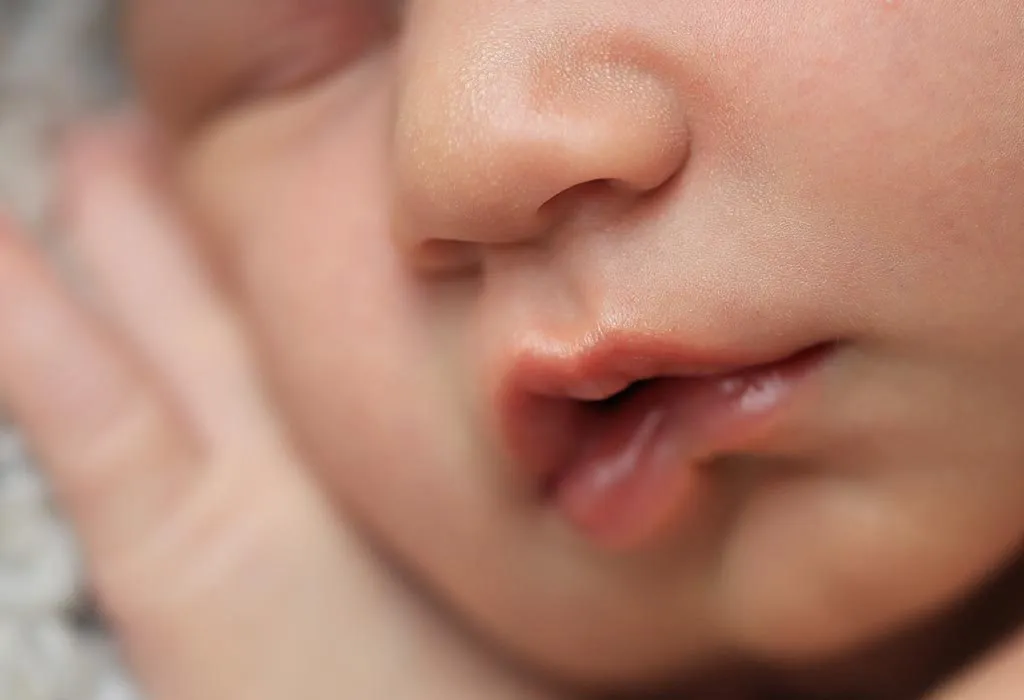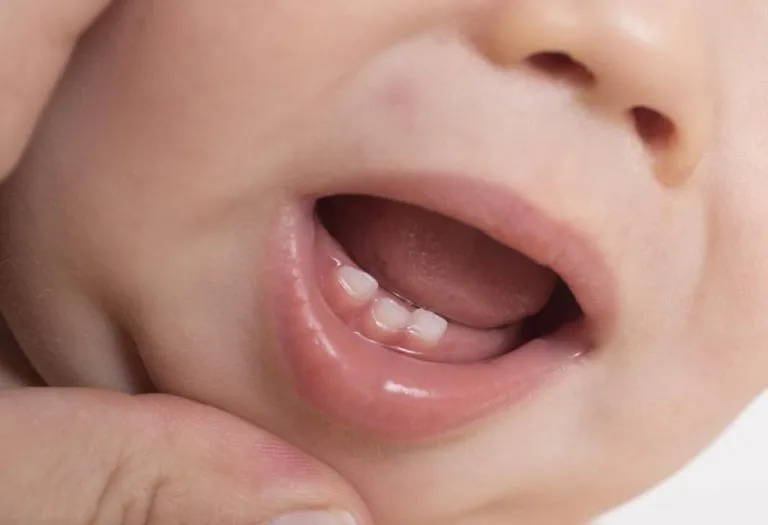Lip Tie in Baby – Causes, Signs, and Treatments
- What Is a Lip Tie?
- How Common Is It?
- What Are the Causes of Lip Ties in Babies?
- If a Baby Has a Lip Tie, Does It Mean He Will Also Have a Tongue Tie?
- Signs and Symptoms of Lip Tie in Babies
- Classification of Lip Tie in Babies
- What Problems Do Babies With Lip Tie Face?
- How Does Lip Tie Affect Breastfeeding?
- How Is a Lip Tie Diagnosed?
- How Is a Lip Tie Treated?
- Post Treatment Care
- When to Consult a Doctor/Lactation Consultant
- FAQs
A lip tie, though not painful or dangerous, can affect the quality of life of a baby. It can also make breastfeeding a frustrating experience for both the mother and the baby. A lip tie restricts the full movement of the baby’s upper lip, making it difficult for them to feed. In rare cases, lip tie could affect speech. Fortunately, it can be fixed if addressed early in life. The good news is that lip ties often improve on their own as children age, and surgery is not especially needed to correct lip ties. Read this informational piece on lip tie in babies and consult your doctor if you have doubts or concerns.
What Is a Lip Tie?
A lip tie is a condition that occurs when the membranes behind the upper lip are too stiff or too thick to allow the upper lip to move normally (1). Lip ties can come in varying grades, depending on which babies may or may not be able to breastfeed easily. Some cases of lip tie allow the baby to breastfeed for years together without any treatment.
How Common Is It?
According to a 2017 study published in the Cochrane Library, 4 to 11% of newborn babies have lip ties, which makes it relatively common (2). A lip tie is similar to a tongue tie, a condition wherein there is a thick band of tissue connecting the bottom of the baby’s tongue to the floor of the mouth (3). A lip tie usually comes with a tongue tie. There could be tongue ties without lip ties, but the vice versa is not fully true. A severe case of tongue tie along with lip tie can make breastfeeding difficult for babies (4). Therefore, babies may have trouble gaining weight (5). A lip tie isn’t much of a concern if your baby is gaining weight as per his age.
What Are the Causes of Lip Ties in Babies?
There is no one particular cause for the occurrence of lip tie in babies. Simply put, some babies are born with a lip tie while others are not. The condition of a lip tie may develop within the womb itself. While most experts think that this might be attributed solely to genetics, this theory has never been proven.
If a Baby Has a Lip Tie, Does It Mean He Will Also Have a Tongue Tie?
Yes, as mentioned above, an isolated lip tie is very uncommon. If a baby is diagnosed with a lip tie, he will have a tongue tie, too. However, the grade of lip/tongue tie will differ, and it may or may not affect breastfeeding and weight gain.
Signs and Symptoms of Lip Tie in Babies
A lip tie is one of the most under-diagnosed conditions. Since its occurrence is rare and most of its symptoms are similar to those of a tongue tie, lip ties usually slip under the radar (6). However, this is where you need to trust your instinct and make a note of all the signs you see in your baby. With a lip tie, not only will your baby show symptoms, but even you will feel and notice the signs given below.
It is essential to know that most of these signs of lip tie in newborns are apparent. A baby can have a lip tie without any of these symptoms, as it all depends on the grade of the tie.
Signs in Babies (7)
- Poor latching
- Sucking strongly to create a vacuum
- Clicking sound when nursing
- Inadequate milk transfer
- Unsatisfactory weight gain or weight loss
- Colicky
- Gas and reflux
- Fussiness and moving away from the breast
- Coughing, choking or gulping when feeding
- Chewing or biting the nipple

Signs in Mothers
Depending on the grade of lip tie, a mother may or may not feel any of the symptoms given below.
- Uncomfortable feeding sessions
- Mastitis
- Low milk supply
- Change of shape of nipples
- White stripe across the nipple
- Plugged ducts
- Breast pain
We’ve mentioned the term ‘grade of lip tie’ several times in the article above. Read on to learn a better classification of each grade.
Classification of Lip Tie in Babies
Lip ties can be classified into four different types as per their severity.
- Class one of lip ties has no significant attachment. It is very rare in kids.
- Class two lip ties are attached primarily to the gums.
- Class three lip ties are attached to the area where teeth grow in future.
- Class four lip ties are the most severe and are attached all the way to the palate of the mouth.
Depending on what class the lip tie is, a baby may or may not face issues during his growth years. But what are the issues seen if a baby has a severe case of lip tie? Well, breastfeeding is one, but there are some more. Continue reading to know them.
What Problems Do Babies With Lip Tie Face?
Although not necessarily true, babies with severe lip ties could face a lot of problems in everyday life. However, those with class three lip ties can be perfectly fine.
You can keep your eyes open for the signs and seek medical attention to prevent these issues for severe lip ties:
- They can struggle to gain weight.
- They are far more likely to become colicky.
- They may struggle to latch onto the nipple.
- They may likely need to be fed in clusters.

How Does Lip Tie Affect Breastfeeding?
The issues mothers and babies experience due to lip ties vary in each case; therefore, it should be taken on a case-by-case basis. In some instances, the mother can continue to feed without pain, and her baby will gain weight perfectly well and get all the nutrition. In the case of a class four lip tie, breastfeeding could be a little difficult as the baby might not be able to latch onto the breast because of the lip tie and may not get sufficient milk per feed. Mothers may try frequent feeding; however, a lot of mothers struggle through it as well when the latch is not right.
Some mothers might also experience sore or painful nipples due to latching issues, whether it is because of lip tie or tongue tie. An incorrect latch could also be the reason for nipple pain after one feed or many feeding; therefore, the latch needs to be corrected either by suck training, revision, or by other methods, depending on the case. This results in lip tie, leading to nipple trauma as well (8). Some experts also state that bottle feeding is not a solution to a breastfeeding problem. Therefore, consulting your paediatrician is highly recommended.
How Is a Lip Tie Diagnosed?
A lip tie is diagnosed through a physical exam. Most paediatricians can diagnose a lip tie based on its appearance, and you can talk to your baby’s paediatrician. However, the ideal option would be to consult a lactation specialist. You can also visit an orthodontist who specialises in infant dentistry for the diagnosis of a lip tie and its severity.
How Is a Lip Tie Treated?
A lip tie is treated by observing the seriousness of its condition and by checking if the baby’s feeding is affected. Most doctors advise against further treatments for lip tie at an early age if the baby can breastfeed normally. If it affects the breastfeeding dyad, the lip tie needs to be revised, and it can be done using scissors or a laser. This treatment needs to be followed by stretching exercises so that the tie does not reattach. If breastfeeding is not affected, most doctors will let it be. Having said that, finding a supporting doctor is important as not all doctors support the revision of ties.
What Happens During the Lip Tie Reversal Procedure?
If your baby’s doctor recommends lip tie surgery, there is no need to panic, as the surgery is quite simple and quick. The revision can be done using a laser or a pair of scissors. It is usually done by a pediatric dentist, and having a lactation consultant on board when this is done is important. The pediatric dentist and a lactation consultant work as a team when it comes to revising tongue ties. The doctor could apply an infant-friendly anaesthetic or numbing agent in the baby’s mouth. After approximately 30 seconds, he/she will cut the lip tie either with a pair of sterilised scissors or a laser. It is recommended to breastfeed pretty much right after the procedure.
Post Treatment Care
There are a number of oral exercises that can ease the pain to an extent and heal your baby. Here are a few things you need to do after the procedure.
- If you are afraid that the pain is going to be extreme, you can ask the doctor to prescribe a pain-relieving medicine or ointment that is safe for kids.
- It is critical that you breastfeed your baby once before the procedure and once immediately after. Breastfeeding immediately after the surgery is a natural way to relieve any pain your little one faces.
- Increase skin-to-skin contact with your baby. You can opt for kangaroo care for your baby or let him suckle on your shoulders or palms. Hold him in your arms and give him access to a clean part of your skin – your baby will suckle on your skin for pain relief, too.
- In case the post-procedure pain seems unbearable for your child, and he becomes fussy or cries incessantly, then you can give him paracetamol or ibuprofen after checking with the paediatrician.
- You can also use an ice cube on the affected area. Ice will numb the area and lower the inflammation.
- Keep teething toys handy to help your baby develop good teething habits – these toys will also help relieve pain.
- Certain suckle exercises and sucking techniques for the baby can be tried after the procedure. You should make sure your baby tries the doctor-recommended techniques.
The doctor will recommend certain stretching exercises so that the tie does not reattach and get the baby to suck stronger.
When to Consult a Doctor/Lactation Consultant
You may take your baby to a doctor/lactation consultant if you notice feeding issues, whether to diagnose the condition or after revising it. A lactation consultant would guide you through and provide tips to manage any feeding issues that are more likely to happen due to incorrect latch.
FAQs
1. Can a lip tie cause speech problems in a child?
Speech problems due to lip tie are extremely rare and are only possible if the condition is very severe. You need not worry – consult your doctor for further information about your child’s case specifically.
2. Can lip tie be a reason for tooth decay?
In general, babies with a lip tie don’t get proper oral care because of the condition itself. It could affect the two teeth (the incisors) on either side of the lip tie.
3. Do lip ties need to be corrected necessarily in babies?
Lip ties don’t always need medical intervention; they usually shrink and correct on their own as children age. Many times, it is also seen that a lip tie does not hinder the feeding ability of the child, nor does it require medical intervention.
Some lip ties in infants may be very short and stiff, which could hinder the ability to feed properly and loosen gums. Such cases must be diagnosed properly by a doctor.
Remember, lip tie is not a condition with dangerous implications, and it can be corrected easily. Don’t try treating the condition at home or cutting your baby’s lip to fix it yourself. Follow your doctor’s instructions to ensure your child is cared for in the best way possible.
References/Resources:
1. Kotlow. L. A; Diagnosing and understanding the maxillary lip-tie (superior labial, the maxillary labial frenum) as it relates to breastfeeding; J Hum Lact.; PubMed; https://pubmed.ncbi.nlm.nih.gov/23821655/; November 2013
2. O’Shea. J. E, et al.; Frenotomy for tongue‐tie in newborn infants; Cochrane Database of Systematic reviews; https://www.cochranelibrary.com/cdsr/doi/10.1002/14651858.CD011065.pub2/full; March 2017
3. Tongue-tie (ankyloglossia); Mayo Clinic; https://www.mayoclinic.org/diseases-conditions/tongue-tie/symptoms-causes/syc-20378452
4. Kotlow. L. A; Diagnosing and Understanding the Maxillary Lip-tie (Superior Labial, the Maxillary Labial Frenum) as it Relates to Breastfeeding; Journal of Human Lactation; https://journals.sagepub.com/doi/10.1177/0890334413491325; July 2013
5. Shekher. R, et al.; How to Treat a Tongue-tie: An Evidence-based Algorithm of Care; Plastic and Reconstructive Surgery – Global Open; https://journals.lww.com/prsgo/fulltext/2021/01000/how_to_treat_a_tongue_tie__an_evidence_based.26.aspx; January 2021
6. Potock. M; Just Flip the Lip! The Upper Lip-tie and Feeding Challenges; ASHAWIRE; https://leader.pubs.asha.org/do/10.1044/just-flip-the-lip-the-upper-lip-tie-and-feeding-challenges/full/; March 2015
7. Freeman. C. G, et al.; Labial Frenotomy for Symptomatic Isolated Upper Lip Tie; Cureus; https://www.cureus.com/articles/114751-labial-frenotomy-for-symptomatic-isolated-upper-lip-tie#!/; December 2022
8. Ankyloglossia (Tongue-tie) and tied maxillary frenum (lip-tie) – Guidelines; Alaska Native Medical Center; https://anmc.org/files/AnkyloglossiaFrenum.pdf
Also Read:
Baby’s Lip Quivers
Baby’s Chapped Lips
Cleft Lips and Palate in Babies
Was This Article Helpful?
Parenting is a huge responsibility, for you as a caregiver, but also for us as a parenting content platform. We understand that and take our responsibility of creating credible content seriously. FirstCry Parenting articles are written and published only after extensive research using factually sound references to deliver quality content that is accurate, validated by experts, and completely reliable. To understand how we go about creating content that is credible, read our editorial policy here.























